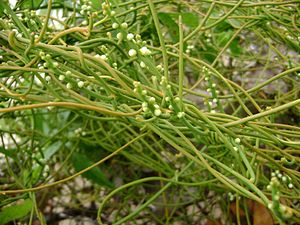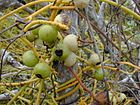Note: This is a project under development. The articles on this wiki are just being initiated and broadly incomplete. You can Help creating new pages.
Difference between revisions of "Cassytha filiformis - Akashavalli"
(→References) |
(→Common names) |
||
| (10 intermediate revisions by 3 users not shown) | |||
| Line 1: | Line 1: | ||
[[File:Cassytha filiformis flower.jpg|thumb|right|''Akashavalli'', ''Cassytha filiformmis'']] | [[File:Cassytha filiformis flower.jpg|thumb|right|''Akashavalli'', ''Cassytha filiformmis'']] | ||
| − | '''Akashavalli''is leafless parasitic climbing twiner, that can be seen growing in South India in very dry gravelly localities. | + | '''Akashavalli'''is leafless parasitic climbing twiner, that can be seen growing in South India in very dry gravelly localities. |
| − | |||
==Uses== | ==Uses== | ||
| − | {{Uses|Dysentery}}, {{Uses|Skin diseases}}, {{Uses|Hair | + | {{Uses|Dysentery}}, {{Uses|Skin diseases}}, {{Uses|Hair problems}}, {{Uses|Dairrhea}} |
<ref name="Uses"/> | <ref name="Uses"/> | ||
| Line 10: | Line 9: | ||
==Chemical Composition== | ==Chemical Composition== | ||
| + | The plant contains aporphine alkaloids.<ref name="Chemical composition"/> | ||
==Common names== | ==Common names== | ||
| − | {{Common names|kn= | + | {{Common names|kn= ಆಕಾಶಬಳ್ಳಿ Akasha balli, ಅಮರ ಬಳ್ಳಿ Amaru balli|ml=Manjadiacatsjavalli, Aiyapala, Akashavalli|sa=Akashavalli, Amrtavalli, Khavalli|ta=Amaravalli, Ammaiyarkoonthal, |te=Antharavallithige, Nooluthige|hi=Amarbeli|en=Love vine |mr=Akashvel, Amarvel}}. |
<ref name="Common names"/> | <ref name="Common names"/> | ||
| Line 39: | Line 39: | ||
===Flower=== | ===Flower=== | ||
| − | {{Flower|Bisexual| Spikes terminal or axillary; peduncle 2-4.5 cm | + | {{Flower|Bisexual| Spikes terminal or axillary; peduncle 2-4.5 cm.}} |
<ref name="Flower"/> | <ref name="Flower"/> | ||
===Fruit=== | ===Fruit=== | ||
| Line 47: | Line 47: | ||
==List of Ayurvedic medicine in which the herb is used== | ==List of Ayurvedic medicine in which the herb is used== | ||
| − | |||
==Where to get the saplings== | ==Where to get the saplings== | ||
| Line 70: | Line 69: | ||
<references> | <references> | ||
| − | <ref name="Uses">http://www.ayurvedavignan.com/2011/08/adenanthera-pavonina.html " | + | <ref name="Uses">[http://www.ayurvedavignan.com/2011/08/adenanthera-pavonina.html Uses]</ref> |
| − | + | <ref name="Chemical composition">[http://gbpihedenvis.nic.in/PDFs/Glossary_Medicinal_Plants_Springer.pdf Chemical composition]</ref> | |
| − | <ref name="Flower">[http://FLOWERING PLANTS OF KERALA VER.2, N. Sasidharan | + | <ref name="Flower">[http://FLOWERING PLANTS OF KERALA VER.2, N. Sasidharan BOTANIC DESCRIPTION]</ref> |
| − | <ref name="Common names">[http://envis.frlht.org/bot_search | + | <ref name="Common names">[http://envis.frlht.org/bot_search Vernacular names]</ref> |
| − | <ref name="Cultivation details">[https://pdfs.semanticscholar.org/baf0/4298592a0fcdbf60970f21f4ebfffcdace69.pdf | + | <ref name="Cultivation details">[https://pdfs.semanticscholar.org/baf0/4298592a0fcdbf60970f21f4ebfffcdace69.pdf Cultivation details]</ref> |
| − | |||
| − | |||
</references> | </references> | ||
==External Links== | ==External Links== | ||
| − | * http://tropical.theferns.info/viewtropical.php?id=Cassytha+filiformis | + | * [http://tropical.theferns.info/viewtropical.php?id=Cassytha+filiformis Cassytha filiformis on the ferns.info] |
| − | http://www.imedpub.com/articles/pharmacological-activities-of-cassytha-filiformis-a-review.pdf | + | * [http://www.imedpub.com/articles/pharmacological-activities-of-cassytha-filiformis-a-review.pdf Cassytha filiformis on imedpub.com] |
Latest revision as of 16:29, 5 October 2020
Akashavalliis leafless parasitic climbing twiner, that can be seen growing in South India in very dry gravelly localities.
Contents
- 1 Uses
- 2 Parts Used
- 3 Chemical Composition
- 4 Common names
- 5 Properties
- 6 Habit
- 7 Identification
- 8 List of Ayurvedic medicine in which the herb is used
- 9 Where to get the saplings
- 10 Mode of Propagation
- 11 How to plant/cultivate
- 12 Commonly seen growing in areas
- 13 Photo Gallery
- 14 References
- 15 External Links
Uses
Dysentery, Skin diseases, Hair problems, Dairrhea [1]
Parts Used
Chemical Composition
The plant contains aporphine alkaloids.[2]
Common names
| Language | Common name |
|---|---|
| Kannada | ಆಕಾಶಬಳ್ಳಿ Akasha balli, ಅಮರ ಬಳ್ಳಿ Amaru balli |
| Hindi | Amarbeli |
| Malayalam | Manjadiacatsjavalli, Aiyapala, Akashavalli |
| Tamil | Amaravalli, Ammaiyarkoonthal, |
| Telugu | Antharavallithige, Nooluthige |
| Marathi | Akashvel, Amarvel |
| Gujarathi | NA |
| Punjabi | NA |
| Kashmiri | NA |
| Sanskrit | Akashavalli, Amrtavalli, Khavalli |
| English | Love vine |
. [3]
Properties
Reference: Dravya - Substance, Rasa - Taste, Guna - Qualities, Veerya - Potency, Vipaka - Post-digesion effect, Karma - Pharmacological activity, Prabhava - Therepeutics.
Dravya
Rasa
Guna
Veerya
Vipaka
Karma
Prabhava
Habit
Identification
Leaf
| Kind | Shape | Feature |
|---|---|---|
Flower
| Type | Size | Color and composition | Stamen | More information |
|---|---|---|---|---|
| Bisexual | Spikes terminal or axillary; peduncle 2-4.5 cm. | {{{3}}} | {{{4}}} | {{{5}}} |
Fruit
| Type | Size | Mass | Appearance | Seeds | More information |
|---|---|---|---|---|---|
| A drupe | Drupe globose, enclosed within inflated perianth, crowned by lobes; seed 1. | {{{6}}} |
Other features
List of Ayurvedic medicine in which the herb is used
Where to get the saplings
Mode of Propagation
How to plant/cultivate
Seeds require scarification before sowing. [5]
Commonly seen growing in areas
Photo Gallery
References
External Links
Categories:
- Ayurvedic Herbs known to be helpful to treat Dysentery
- Ayurvedic Herbs known to be helpful to treat Skin diseases
- Ayurvedic Herbs known to be helpful to treat Hair problems
- Ayurvedic Herbs known to be helpful to treat Dairrhea
- Herbs with Stem used in medicine
- Herbs with common name in Kannada
- Herbs with common name in Hindi
- Herbs with common name in Malayalam
- Herbs with common name in Tamil
- Herbs with common name in Telugu
- Herbs with common name in Marathi
- Herbs with common name in Sanskrit
- Herbs with common name in English
- Habit - Climber
- Herbs that are commonly seen in the region of Tropical area
- Herbs
- Deccan
- Lauraceae




